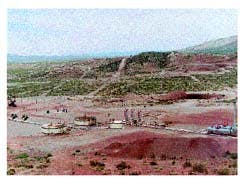YPF LAUNCHES DIVERSE ATTACK IN PURSUIT OF PRODUCTION
The objective of the near term program is to replace between 100 and 110% of the reserves produced and to increase oil production by 20%/year between 1993 and 1995. Oil production in 1994, according to YPF, was 351,000 b/d, 11% over 1993.
Exploration is directed at medium risk/medium reward prospects. Oil prospects are favored over gas.
The development work will go for new wells, workovers, secondary recovery, facilities, joint ventures, and the environment. The latter involves primarily cleaning up and bioremediating hundreds of old waste oil, mud, and produced water pits. The worst of these will be cleaned by this coming March.
As a result of the exploration and production program, the company had the following rigs working on land during the fourth quarter of 1994:
- Neuquen, 17 in development work, 13 in exploration
- San Jorge, 25 in development, 8 in exploration
- Mendoza, 7 in development, 13 in exploration.
The rigs come from the U.S., Bolivia, Chile, and Argentina. Estenssoro expects YPF to drill 1,300 exploration and production wells in 1995. Other companies should drill an additional 300 wells, he thinks, for a total of 1,600 wells.
OFFSHORE
Although Argentina's offshore area has yet to yield any oil, it stirs the most excitement because of its huge size, the minimal amount of exploration done there to date, and the shallowness of the water.
Marcelo Guiscardo, vice-president of exploration and production, says: "We are aching to look at the unexplored areas there."
The first well in the Colorado Marine basin drilled by Union Texas Petroleum with YPF participating, finished up in May 1994. It went to 4,300 m and found oil-bearing rock and oil remains. The Colorado Marine basin extends south of a line running essentially eastward from Bahia Blanca
"We know," Guiscardo says, "this basin has concentrations of hydrocarbons (Fig. 1, p. 46)."
YPF and Union Texas, the operator, are reviewing the results and plan two more wells this year. The first of these will be spudded next month.
Brazil's Petrobras and YPF began another test in October last year in another virgin area, the San Julian basin.
Guiscardo says all the basic conditions are present offshore to make it attractive: onshore formations that extend offshore at the same depth and good seismic and geological surveys.
"We expect to find something," he says. "It is just a matter of time."
BOLIVIA
Last fall YPF inked a major deal with Bolivia's state-owned oil company Yacimientos Petroliferos Fiscales Bolivianos (YPFB) to explore the Montero and Charagua areas in eastern Bolivia, respectively, north and south of the city of Santa Cruz. The Montera block covers 1.85 million acres; the Charaga block 1 million acres. Argentina already imports 200 MMcfd of gas from Bolivia.
YPF will invest $36 million in Charagua and $14 million in Montero. If commercial quantities of hydrocarbons are found, the agreement will last 30 years. Finding more gas in Bolivia and northwest Argentina could set YPF well on the road to reaching the El Dorado it hopes to find in the gas markets of Sao Paulo, one of the world's mega cities.
RINCON DE LOS SAUCES
For the time being though, it appears that for YPF there is no place like home. That is in its production sector of Rincon de Los Sauces (RLS), the brightest star in YPF's production firmament.
There is a lot going on there. A "snapshot" of activity there last September reveals the tempo and diversity.
Sixteen rigs were doing development drilling; ten exploratory work. At the same time, eight completion rigs were working on development wells, another eight on exploratory wells. Four pulling units and four paraffin cleaning units were also busy.
On the strategic agenda this year are secondary recovery projects, greater use of 3D seismic, fifty horizontal wells, and exploitation of a formation in the Jurassic.
To date, the main source of production has been from the Cretaceous. A well designated the Chihuido X-391, about 20 miles northeast of Rincon de los Sauces and near the provincial Neuguen/Mendoza border, is the first to record continuous production from the Jurassic. The formation is the Tordilla at about 2,500 m depth. YPF explorationists are optimistic that these sediments will be productive elsewhere in the Neuguen basin.
The horizontal wells will be aimed at a 5 m thick sandstone formation at 1,000 m in the Cretaceous. The laterals are planned to go 500 m horizontally in a thin zone not attractive for vertical exploitation. The horizontal drilling is not expected to significantly increase production, rather to have a stabilizing influence on output.
SON JORGE BASIN
The San Jorge basin is the second largest of the country's five productive basins with an area of 32 million acres (Fig. 1) (79084 bytes). Of these, 23 million (74%) are classified by YPF as frontier acreage. The basin is a cretaceous basin of continental origin. The reservoirs are made up of river sandstone spread over a large area of multiple layers.
In recent months, the San Jorge basin accounted for about 30% of Argentina's oil output. YPF's reserves in the basin represent 37% of the company total. The company's average production there in December 1994 was 118,000 b/d.
During 1994, YPF carried out intensive exploration and development activities in the area, drilling 558 wells, 65% of YPF's total wells in the country. Of the total in the basin, 35 were exploratory wells.
The estimated production in 1995 is 130,000 b/d with an exploration and development program of 850 wells. Total basin production is expected to be 250,000 b/d in 1995 compared to 216,000 b/d last year. The main activity will be carried out in Las Heras, where Los Perales and Barranca Baya oil fields are located. It is considered the most promising area in the basin. Producing formations range in depth from 2,100 to 10,800 ft.
Copyright 1995 Oil & Gas Journal. All Rights Reserved.
